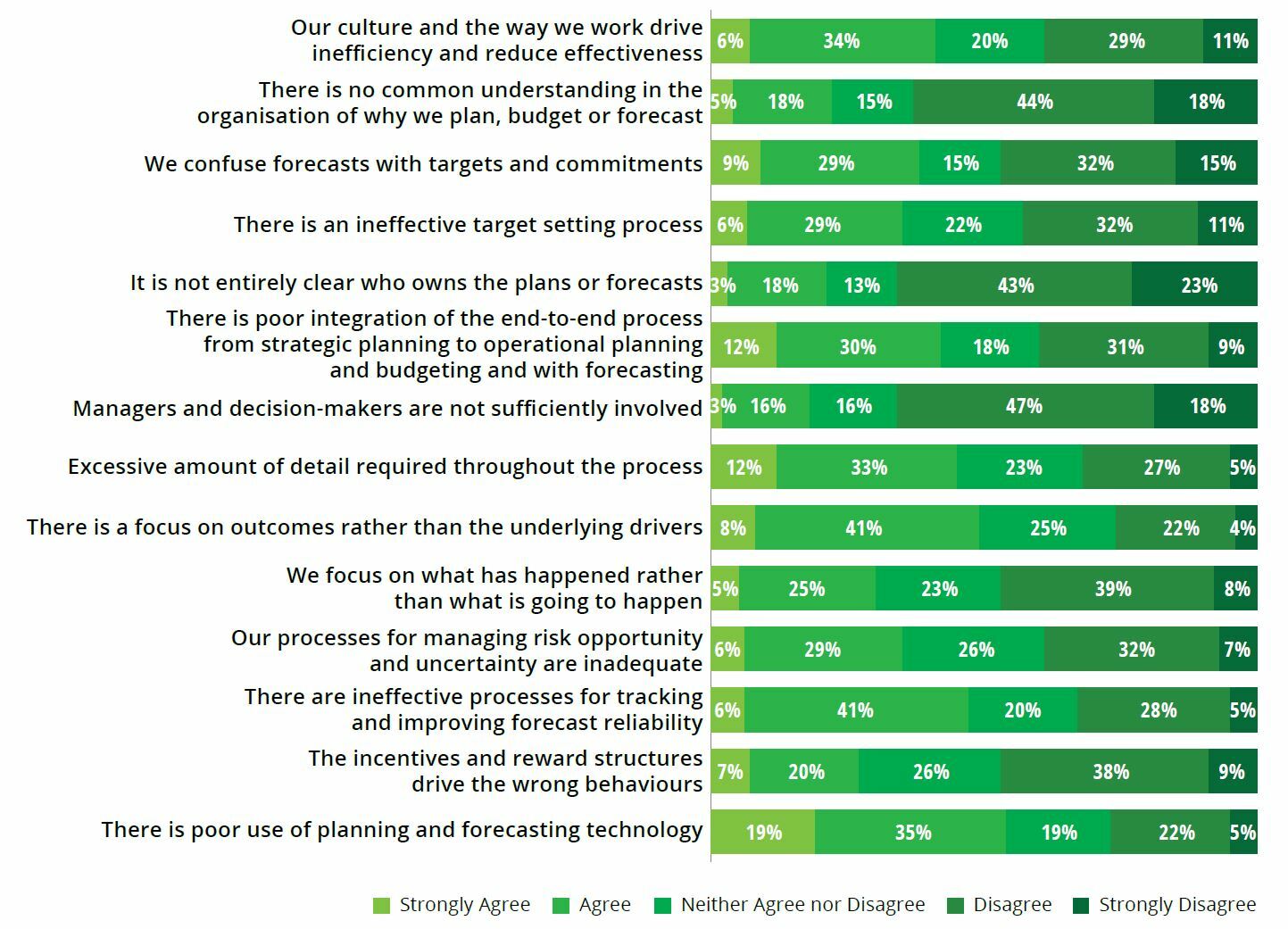Effective planning, budgeting & forecasting
Organisations are continuing to evolve and are making several strategic decisions to change ways in which they operate, go-to-market, and evolve business models. Planning, budgeting and forecasting processes need to adapt to this change and must be embedded within any strategic changes implemented across organisations.
Measuring the effectiveness of the planning, budgeting and forecasting process can be done across several parameters. Examples include: defining clear roles and ownership, use of rolling forecasts, integration across planning and forecasting, use of technology tools and other measuring techniques.
Our survey drilled into a number of these practices to understand the current trends across organisations.
To drive better insight, we segmented “leading practice” organisations on the basis that they have replied positively to 10 or more of the 14 questions. These leading organisations represent some 23% of respondents, and the results are generally very similar across industry clusters, size of organisation and revenue.
To what extent do you agree or disagree with the following statements regarding the key challenges to effective planning, budgeting & forecasting in your organisation?

Overall, most participants feel that there is a common understanding of the purpose behind planning, budgeting and forecasting, clarity on ownership and proper involvement of managers and decision-makers.
However, the underlying application of best practice principles are lacking. For example, focus on outcomes rather than the underlying drivers of performance, poor use of technology, poor process integration and treating forecasts as targets rather than a best- estimate of forward performance.
Most critically, organisations where forecasts are treated as targets, with poor process integration and unclear ownership, also experience poor forecast reliability as well as ineffective target-setting.

End-to-end integration of PB&F Processes
Organisations with a common understanding of PB&F practices are more likely to have connected functions (76% vs 58%) compared to those where the purpose of planning and forecasting seems to be less clear. In addition, leading organisations are twice as likely to have connected functions compared to the rest.
What are the major roadblocks when trying to adopt Connected Planning?
The major roadblocks to adopting connected planning are disconnected systems, lack
of standardised process, organisational structure and governance, and commitment from management.
This view is slightly different for leading organisations where different target and performance incentives are also identified as key roadblocks.
For the remainder of our respondents, we should also highlight a culture that is lacking in collaboration as a key impediment to a more connected PB&F process.

Why we plan, budget and forecast
Planning, budgeting and forecasting are quite different processes, each with a different purpose. Understanding the purpose and alignment of each of these processes is critical to an effective performance management framework. 62% of the respondents believe that there is a common understanding
in the organisation of why they plan, budget and forecast, which has worsened from our 2014 results (70%).
However, as we would expect, leading organisations are twice as likely to have a better understanding of PB&F compared to the rest, suggesting the importance of understanding the scope of PB&F to fully unleash the benefits of effective PB&F.
Budgets should be used to communicate and cascade targets and to develop operational plans to deliver against strategic goals in the short term. Forecasts, when used properly, provide the best view of the likely outcome based on current trajectory, thus allowing course adjustments and correction. Being clear about these quite different purposes lead to clearer communication, clearer targets, more robust plans and a nimbler organisation tuned to the changing environment.
Forecasting – Predicting Performance
Nearly half of the respondents say they only look at financial outcomes rather than the drivers of those outcomes. Focusing on the underlying drivers of revenue and cost such as volume, mix, price, productivity, attrition rates etc. will provide a much better understanding of what is happening in the organisation, greater forecast accuracy and more focused decision-making. The survey shows a strong positive correlation between a focus on drivers and more reliable forecasts, with the majority, realising a variance of <5%, which is double the number in organisations that don’t focus on drivers.

Variance between actual revenue and forecast revenue
Organisations with high levels of participation across functions, also enjoy greater forecast accuracy with 77% keeping forecast revenue variances to less than 10%, compared to only 59% of those with lower participation levels.
Forecasting cycles would seem to be getting longer; 50% are able to complete a forecast in under two weeks, which is a slight decline from the 2014 survey at 66%. it is important to target a rapid forecast cycle, certainly no more than two weeks, to ensure that the forecast remains relevant and enables the right decisions to be made.
Another interesting point to highlight is amongst those respondents with higher level of forecasting accuracy (0-5%), half of them can execute a forecast in under two weeks.

Ownership & Participation
Clear ownership and participation for planning and forecasting is vital to ensure plans and forecasts are complete with appropriate ownership targets and commitments to delivery. Two-thirds of respondents feel that ownership and responsibility for plans and forecasts are clear within their organisations. This number is significantly higher for leading organisations at 98%, underlining the importance of ownership for effective PB&F.
Compared to the rest, those who claim to have clear ownership for plans and forecast also report more connected PB&F functions (52% vs 40%), more effective target setting processes (56% vs 43%) and more involvement of managers and decision makers in PB&F processes (80% vs 65%).
65% of respondents have good participation of managers and decision-makers in planning, budgeting and forecasting. There is a clear correlation between stakeholders’ involvement and connectedness.

Use of technology for effective planning, budgeting and forecasting
54% of respondents report that they do not make proper use of planning and forecasting technology, which is much higher than the 35% in 2014 survey. 30% of organisations also report that they use spreadsheets as their main budgeting and forecasting tool and perhaps surprisingly, this is unchanged from 2014.
Organisations who make good use of technology are more likely to have automated management information production and self-service capabilities and we see very similar results for the Leaders. Indeed, it is worth noting that use of technology by leading organisations is very similar to the rest of the survey respondents, perhaps underlining the challenges that many organisations face in making a compelling investment case.
Technology’s benefits are known as respondents with good usage of technology are more likely to get accurate forecasts (45% vs 37%) and a faster cycle time (56% vs 48% execute a forecast
in under two weeks). However, these are not major differences, suggesting that importance of complementing technology with other important organisational and cultural best practices.
Technology continues to be under-utilised and organisations are still struggling with the fundamentals. Cultural barriers remain including an excessive focus on targets rather than business intelligence; incentives, responsibilities and ownership structures that drive siloed and overlapping planning and forecasting. This is where change is at its hardest. Successful and sustained change requires a cultural shift and a clear vision across the entire organisation of what good looks like.
Based on discussions with Chief Financial Officers and Financial Planning & Analysis leaders, we are seeing leading organisations:
- Driving better business performance through adoption of good PB&F practices, by demonstrating greater levels of focus on business drivers, ownership, connectedness and process integration
- Focus on ownership of the planning process through clearly defined RACI’s, to ensure a smooth target setting process and increasing the involvement of decision-makers in the PB&F process
Know the impact of effective planning, budgeting and forecasting
Download the latest reportKey Contact

Martin Jermyn
Global Planning, Budgeting & Forecasting Survey Sponsor





